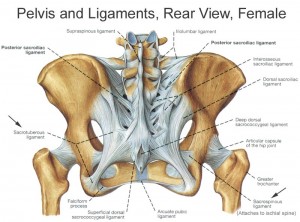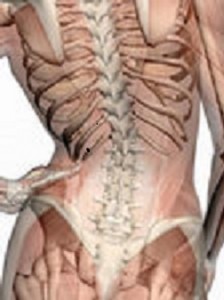Where Did My Low Back Pain Come From?
 Low back pain can come on with no obvious injury. People wonder why. Of course, there can be many different causes, but one we see commonly in our Minneapolis St. Paul Chiropractic Office, is one that surprises many patients! It has to do with:
Low back pain can come on with no obvious injury. People wonder why. Of course, there can be many different causes, but one we see commonly in our Minneapolis St. Paul Chiropractic Office, is one that surprises many patients! It has to do with:
– The “Hip” bones or pelvis
– Ligaments
– “Middle-Aged Spread”
– The largest joint/s in the body
People often point to the pelvis, and call it their “hip”. The “real” pelvis is made up of 3 bones. The 1 in the back and middle, mostly referred to as the “tailbone”, is called the sacrum. On either side of this are 2 larger bones, each called an ilium (sorry for all the Latin; I didn’t name these). Each ilium forms a joint with the sacrum; 1 on the left and 1 on the right. Each one also has a socket on the lower part of it facing towards the side. This is the socket or depression for the “true” hip joint. All 3 parts put together = the pelvis which is shaped much like an upside down triangle, and serves as a foundation for the back.
 The joints of the pelvis – the “true” hips, and those between the sacrum and each ilium, allow such things as standing, getting up and down, walking, running, and generally any motion involving the legs. Motion is the key here, as this is the job of all joints. Also as with all joints, they are held together with ligaments, which are tough fibrous “soft tissues” (meaning other than bone). If you’ve ever “dressed” game when hunting, or prepared a whole chicken for cooking by separating the legs or other parts, you know how tough that can be. A very sharp knife is invaluable, and it can still be quite a job. Ligaments are the tissues that make it so difficult. They are arguably the toughest tissue in the whole body. So much so that with injury, bones can break before ligaments will tear.
The joints of the pelvis – the “true” hips, and those between the sacrum and each ilium, allow such things as standing, getting up and down, walking, running, and generally any motion involving the legs. Motion is the key here, as this is the job of all joints. Also as with all joints, they are held together with ligaments, which are tough fibrous “soft tissues” (meaning other than bone). If you’ve ever “dressed” game when hunting, or prepared a whole chicken for cooking by separating the legs or other parts, you know how tough that can be. A very sharp knife is invaluable, and it can still be quite a job. Ligaments are the tissues that make it so difficult. They are arguably the toughest tissue in the whole body. So much so that with injury, bones can break before ligaments will tear.
“Middle-Age Spread” is a phrase that conjures up images of a widening behind, possibly with extra fat, and a stomach and thighs to match. This spread, however is also a by-product of actual anatomical “widening” of the pelvis. Factors such as aging, repetitive activity as in lots of standing, bending, stretching, stooping, and sitting over a long time (even years), childbirth or previous injury, tends to stretch or cause a “loosening” or laxity of the ligaments holding the 3 pelvic bones together. When this occurs it allows the bones to spread apart. The spreading causes problems for the joints that are being held together by the ligaments. A main problem is that the bones lose their normal position with each other and the joints are allowed to become unstable (moving around when they shouldn’t), or get stuck – even partially. A misalignment or unleveling and tipping of the entire pelvis can occur too, and combinations of any or all three can happen at various times, with all three “playing” off of and leading to one another.
The 2 very important joints in this story are called sacroiliac joints (where the sacrum – “tailbone” and ileums come together). They are the largest joints in the body, and it’s often where people point when talking about their hip. They’re the ones mainly creating and getting into all the trouble when the ligaments stretch, and are in turn responsible for upsetting the pelvic foundation for the back. Once the pelvis sags, tips, twists or unlevels, the back joints and soft tissues like muscles and ligaments have to work differently (adapt), carry body weight in ways they’re not supposed to, and generally just work harder. This all goes on “silently”…at least for awhile, and then when enough stress accumulates the situation “breaks” down. The overworked joints “lock up” and muscles won’t relax. Circulation of blood and other fluids gets disrupted because there isn’t normal motion going on which helps this, and because some of the tissues like muscle are so tight or knotted up that the circulation gets restricted. All this results in inflammation and swelling accumulates. In turn all these problems contribute to irritating nerves, and low back pain pain develops.
blood and other fluids gets disrupted because there isn’t normal motion going on which helps this, and because some of the tissues like muscle are so tight or knotted up that the circulation gets restricted. All this results in inflammation and swelling accumulates. In turn all these problems contribute to irritating nerves, and low back pain pain develops.
Finally, all this has happened without apparent cause or obvious injury, and people are left to wonder why. So if this is you, seek professional help…better yet, be preventative. Get checked and know what “shape” you’re in before “breakdown” has You wondering.
By Dr. William T. Norlin Chiropractor in Minneapolis/St Paul, Minnesota











